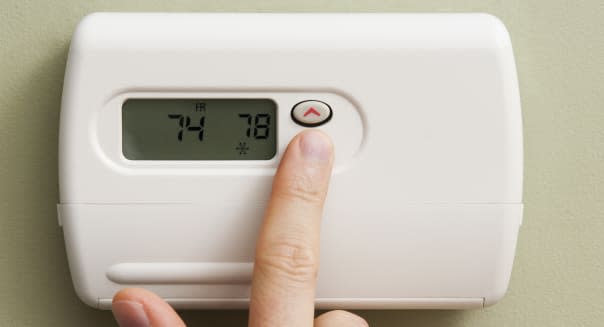How to Cut Your Summer Electric Bill Now

By Abby Hayes
You don't have to replace your entire air-conditioning system to lower your summer electric bills. Maybe a higher-efficiency system is in your future. But until then, take these eight steps right now to reduce your electric bill right away:
1. Install a programmable thermostat. Raising the heat a few degrees in your home is a no-brainer when it comes to saving on electricity. The warmer you let your home get, the less work your air conditioner needs to put in. But who has time to mess with the thermostat every hour?
Instead, install a programmable thermostat. Pick up a basic model at your local hardware store for 30 bucks. Or splurge on a self-regulating model, like the Nest Learning Thermostat, which learns your home-and-away patterns over time.
2. Only use ceiling fans when you're under them. Ceiling fans are more efficient than air conditioners, but leaving them on all the time won't do you much good. A ceiling fan merely circulates air. It won't actually lower the temperature.
Ceiling fans work by making you feel cooler by circulating air against your skin. So only use a ceiling fan when there's someone in the room to feel it. Otherwise, you're just wasting electricity.
3. Install air conditioners in the warmest rooms. Many houses -- especially older ones -- have that one room that just doesn't cool off as well as the other rooms. That one room can cost you a lot of money, especially if it's a bedroom or an often-occupied room. To keep it cool, you may be tempted to turn your thermostat down into the arctic range. The rest of the house will be freezing, but that room will finally be comfortable.
%VIRTUAL-article-sponsoredlinks%But this just wastes money by making your central air-conditioning system work overtime. Instead, spend $75 to $100 on a window or floor unit for that one room. Turn the unit on when you're in the room and need it to be a bit cooler, and then turn it off when you leave again.
4. Keep it clean.Cleaning the air-conditioner filters -- whether you have window units or a central unit -- is just as important as replacing your furnace filter regularly in the winter. When the filter gets dirty, the unit has to work extra hard to pull air into the system, which just costs more energy.
So figure out how to clean your unit's filter, and check it every few weeks in the summer. Many outdoor units can be hosed off regularly, and window units often come with removable filters that you can wash in the sink.
5. Close the drapes or blinds. It's nice to let a little sunshine in -- except that sunny corner the cat enjoys so much is costing you big bucks this summer. When you let the sun in, it radiates heat.
So especially on the south and west sides of your home, keep the blinds or drapes shut unless there's someone in the room actually enjoying the sun.
6. Hang out the laundry. Your dryer is probably one of your home's biggest energy suckers. It takes a lot of electricity (or gas) to generate heat that dries your clothes. Plus, some of that heat escapes the dryer and winds up heating your home unnecessarily.
Let the hot sun work for you instead of against you this summer by hanging your clothes to dry outside on a clothesline. The sun is great for bleaching stains out of white clothes and towels, too!
7. Caulk up cracks. We often talk about using caulk to seal cracks -- especially around doors and windows -- in the winter. And it's true that in the winter, it's especially easy to feel the cold air leaking in through even the tiniest of cracks and gaps.
But caulk is just as important a tool in the summertime, too. If you notice one area or doorway in your home is particularly warm, check for leaks and cracks. Then, use caulk or an expanding foam to fill up the gaps. That keeps the cold air in so that you use less energy to heat your home.
8. Keep the kitchen cool. One way to quickly heat up your home is to use your kitchen appliances to fix meals. Sure, you still need to eat in the summer, but you don't always have to heat up the whole kitchen to do it.
Instead, plan no-cook meals like salads. Or use smaller appliances, like a toaster oven, for moderate amounts of warm food. Another option is to use a slow cooker. For even better results with your slow cooker, move it outside to a shady back porch. Then it won't heat your house at all!
Even if your air conditioner is 10 years old and on its last leg, you can make it last a little longer and cost less money to run this summer with these eight simple steps.
Abby Hayes is a freelance blogger and journalist who writes for personal finance blog The Dough Roller and contributes to Dough Roller's weekly newsletter.

